trailer Hyundai Santa Fe 2009 Owner's Manual - RHD (UK, Australia)
[x] Cancel search | Manufacturer: HYUNDAI, Model Year: 2009, Model line: Santa Fe, Model: Hyundai Santa Fe 2009Pages: 269, PDF Size: 9.78 MB
Page 15 of 269
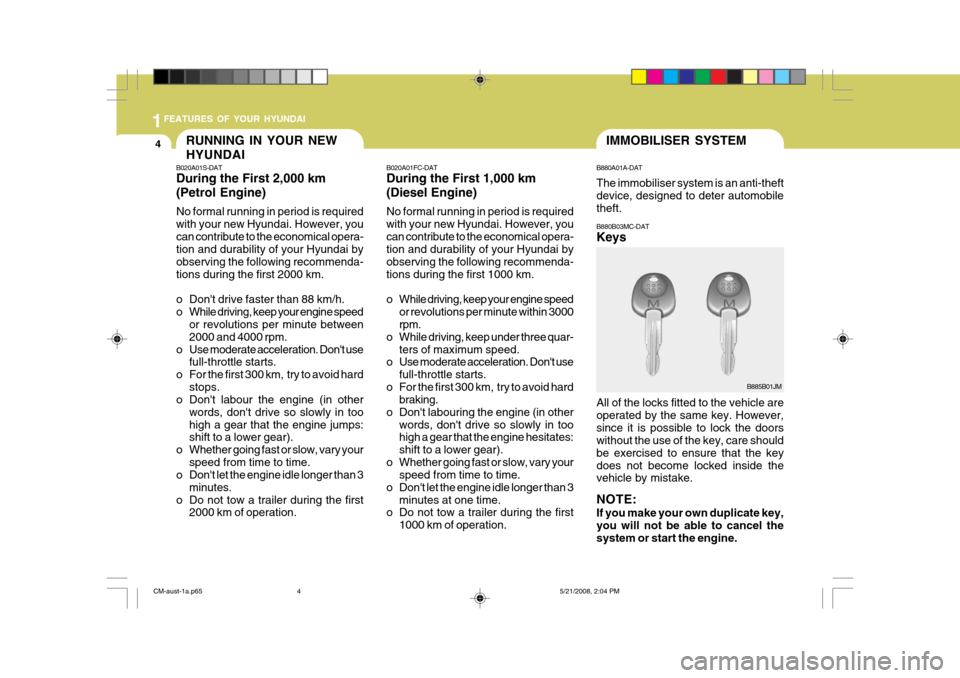
1FEATURES OF YOUR HYUNDAI
4IMMOBILISER SYSTEM
B880A01A-DAT The immobiliser system is an anti-theft device, designed to deter automobile theft. B880B03MC-DAT Keys All of the locks fitted to the vehicle are operated by the same key. However,since it is possible to lock the doors without the use of the key, care should be exercised to ensure that the keydoes not become locked inside the vehicle by mistake. NOTE: If you make your own duplicate key, you will not be able to cancel the system or start the engine.
B885B01JM
B020A01FC-DAT During the First 1,000 km (Diesel Engine) No formal running in period is required with your new Hyundai. However, youcan contribute to the economical opera- tion and durability of your Hyundai by observing the following recommenda-tions during the first 1000 km.
o While driving, keep your engine speed
or revolutions per minute within 3000 rpm.
o While driving, keep under three quar- ters of maximum speed.
o Use moderate acceleration. Don't use
full-throttle starts.
o For the first 300 km, try to avoid hard braking.
o Don't labouring the engine (in other words, don't drive so slowly in toohigh a gear that the engine hesitates: shift to a lower gear).
o Whether going fast or slow, vary your speed from time to time.
o Don't let the engine idle longer than 3
minutes at one time.
o Do not tow a trailer during the first
1000 km of operation.
RUNNING IN YOUR NEW HYUNDAI
B020A01S-DAT During the First 2,000 km (Petrol Engine) No formal running in period is required with your new Hyundai. However, youcan contribute to the economical opera- tion and durability of your Hyundai by observing the following recommenda-tions during the first 2000 km.
o Don't drive faster than 88 km/h.
o While driving, keep your engine speed
or revolutions per minute between2000 and 4000 rpm.
o Use moderate acceleration. Don't use full-throttle starts.
o For the first 300 km, try to avoid hard stops.
o Don't labour the engine (in other
words, don't drive so slowly in toohigh a gear that the engine jumps: shift to a lower gear).
o Whether going fast or slow, vary your speed from time to time.
o Don't let the engine idle longer than 3
minutes.
o Do not tow a trailer during the first 2000 km of operation.
CM-aust-1a.p65 5/21/2008, 2:04 PM
4
Page 105 of 269
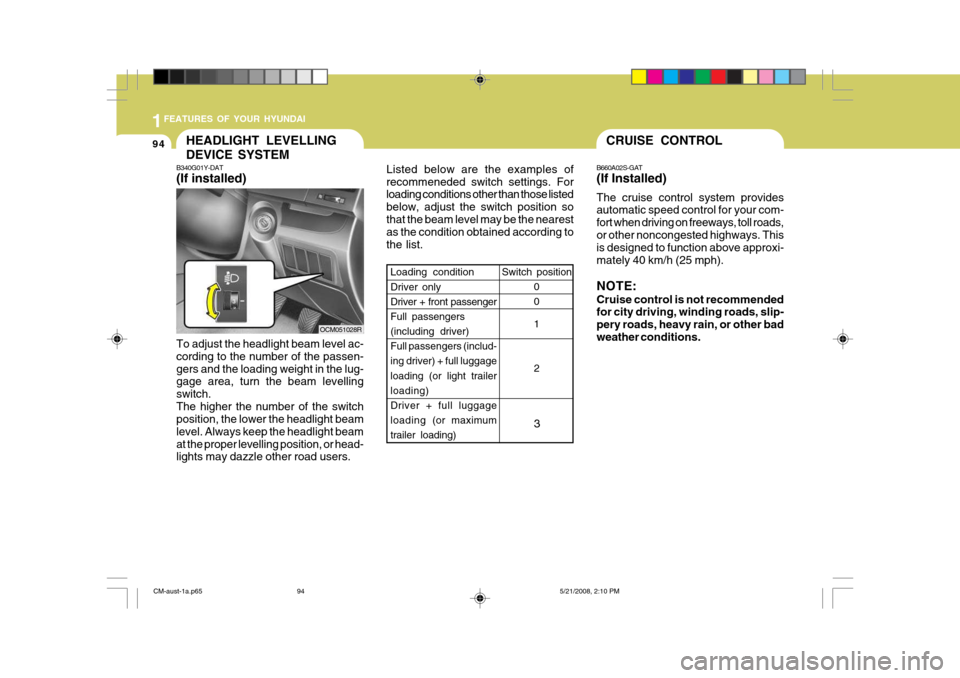
1FEATURES OF YOUR HYUNDAI
94HEADLIGHT LEVELLING DEVICE SYSTEM
B340G01Y-DAT (If installed) To adjust the headlight beam level ac- cording to the number of the passen-gers and the loading weight in the lug- gage area, turn the beam levelling switch.The higher the number of the switch position, the lower the headlight beam level. Always keep the headlight beamat the proper levelling position, or head- lights may dazzle other road users. Listed below are the examples of recommeneded switch settings. For loading conditions other than those listed below, adjust the switch position sothat the beam level may be the nearest as the condition obtained according to the list.
Switch position0 0 1 2 3
Loading condition Driver only Driver + front passengerFull passengers (including driver) Full passengers (includ-ing driver) + full luggage loading (or light trailer loading)
Driver + full luggage
loading (or maximum
trailer loading)
OCM051028R
CRUISE CONTROL
B660A02S-GAT (If Installed) The cruise control system provides automatic speed control for your com- fort when driving on freeways, toll roads,or other noncongested highways. This is designed to function above approxi- mately 40 km/h (25 mph). NOTE: Cruise control is not recommended for city driving, winding roads, slip- pery roads, heavy rain, or other bad weather conditions.
CM-aust-1a.p65 5/21/2008, 2:10 PM
94
Page 146 of 269
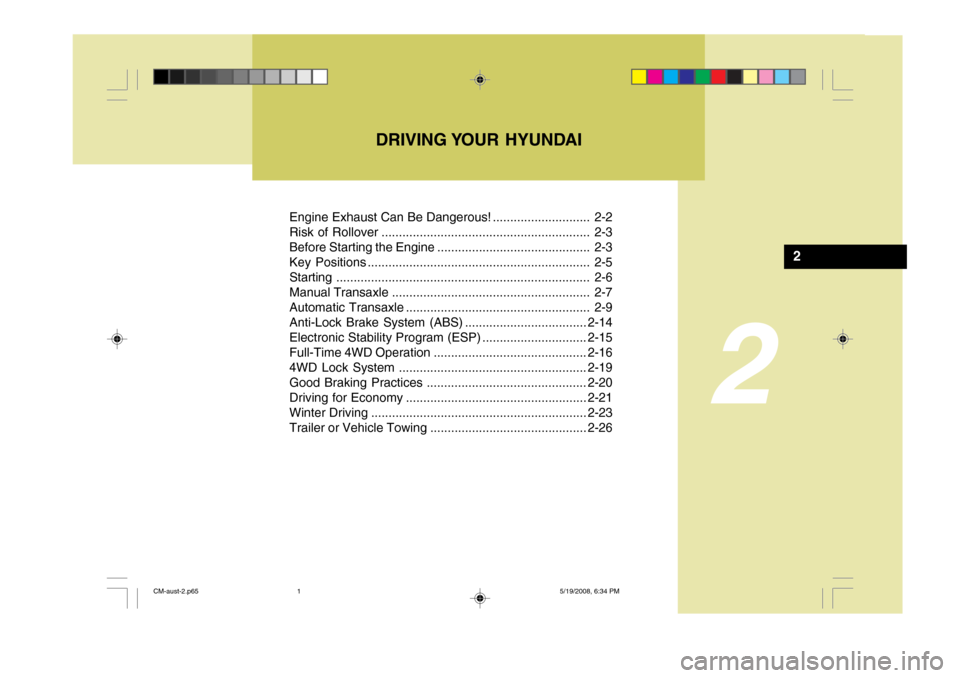
2
Engine Exhaust Can Be Dangerous! ............................ 2-2
Risk of Rollover ............................................................ 2-3
Before Starting the Engine ............................................ 2-3
Key Positions ................................................................ 2-5Starting ......................................................................... 2-6
Manual Transaxle ......................................................... 2-7
Automatic Transaxle ..................................................... 2-9Anti-Lock Brake System (ABS) ................................... 2-14
Electronic Stability Program (ESP) ..............................2-15
Full-Time 4WD Operation ............................................ 2-16
4WD Lock System ...................................................... 2-19
Good Braking Practices .............................................. 2-20
Driving for Economy .................................................... 2-21
Winter Driving .............................................................. 2-23
Trailer or Vehicle Towing ............................................. 2-26
DRIVING YOUR HYUNDAI
2
CM-aust-2.p65
5/19/2008, 6:34 PM
1
Page 171 of 269
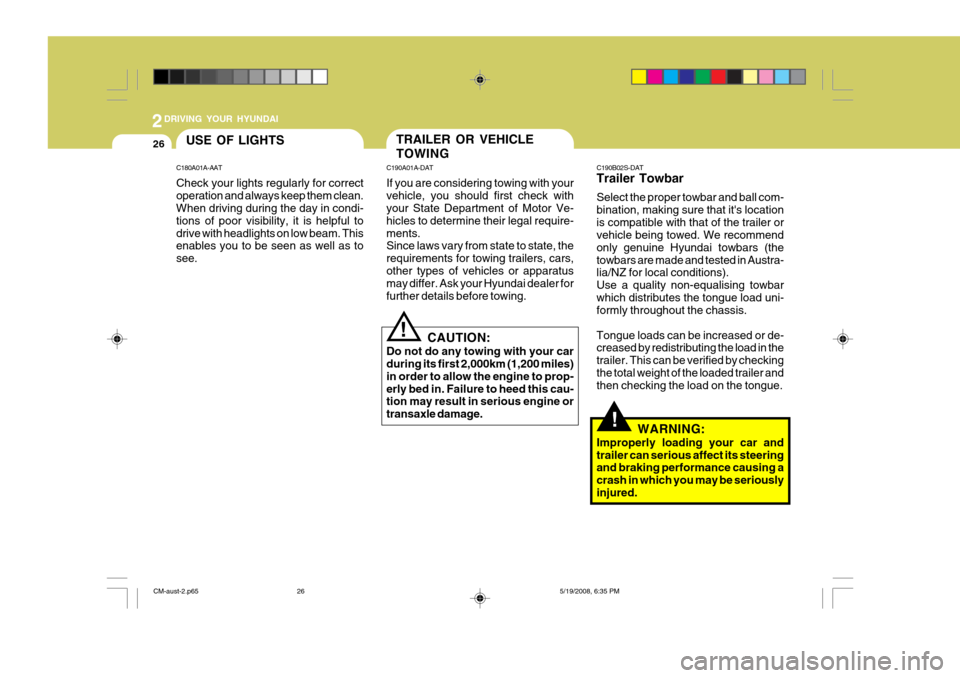
2DRIVING YOUR HYUNDAI
26
!
C190B02S-DAT Trailer Towbar Select the proper towbar and ball com- bination, making sure that it's locationis compatible with that of the trailer or vehicle being towed. We recommend only genuine Hyundai towbars (thetowbars are made and tested in Austra- lia/NZ for local conditions). Use a quality non-equalising towbarwhich distributes the tongue load uni- formly throughout the chassis. Tongue loads can be increased or de- creased by redistributing the load in the trailer. This can be verified by checkingthe total weight of the loaded trailer and then checking the load on the tongue.
WARNING:
Improperly loading your car and trailer can serious affect its steering and braking performance causing a crash in which you may be seriouslyinjured.
TRAILER OR VEHICLE TOWING
C190A01A-DAT If you are considering towing with your vehicle, you should first check with your State Department of Motor Ve- hicles to determine their legal require-ments. Since laws vary from state to state, the requirements for towing trailers, cars,other types of vehicles or apparatus may differ. Ask your Hyundai dealer for further details before towing.
CAUTION:
Do not do any towing with your car during its first 2,000km (1,200 miles) in order to allow the engine to prop-erly bed in. Failure to heed this cau- tion may result in serious engine or transaxle damage.
!
USE OF LIGHTS
C180A01A-AAT Check your lights regularly for correct operation and always keep them clean. When driving during the day in condi- tions of poor visibility, it is helpful todrive with headlights on low beam. This enables you to be seen as well as to see.
CM-aust-2.p65 5/19/2008, 6:35 PM
26
Page 172 of 269
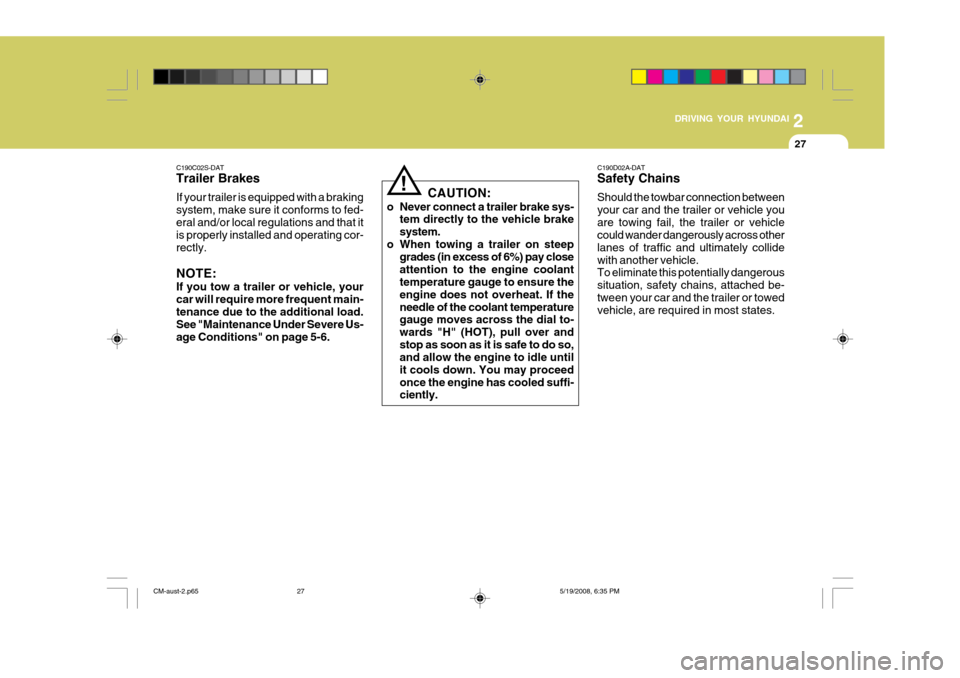
2
DRIVING YOUR HYUNDAI
27
CAUTION:
o Never connect a trailer brake sys- tem directly to the vehicle brake system.
o When towing a trailer on steep grades (in excess of 6%) pay closeattention to the engine coolant temperature gauge to ensure the engine does not overheat. If theneedle of the coolant temperature gauge moves across the dial to- wards "H" (HOT), pull over andstop as soon as it is safe to do so, and allow the engine to idle until it cools down. You may proceedonce the engine has cooled suffi- ciently.
! C190D02A-DAT Safety Chains Should the towbar connection between your car and the trailer or vehicle youare towing fail, the trailer or vehicle could wander dangerously across other lanes of traffic and ultimately collidewith another vehicle. To eliminate this potentially dangerous situation, safety chains, attached be-tween your car and the trailer or towed vehicle, are required in most states.
C190C02S-DAT Trailer Brakes If your trailer is equipped with a braking system, make sure it conforms to fed-eral and/or local regulations and that it is properly installed and operating cor- rectly. NOTE: If you tow a trailer or vehicle, your car will require more frequent main-tenance due to the additional load. See "Maintenance Under Severe Us- age Conditions" on page 5-6.
CM-aust-2.p65
5/19/2008, 6:35 PM
27
Page 173 of 269
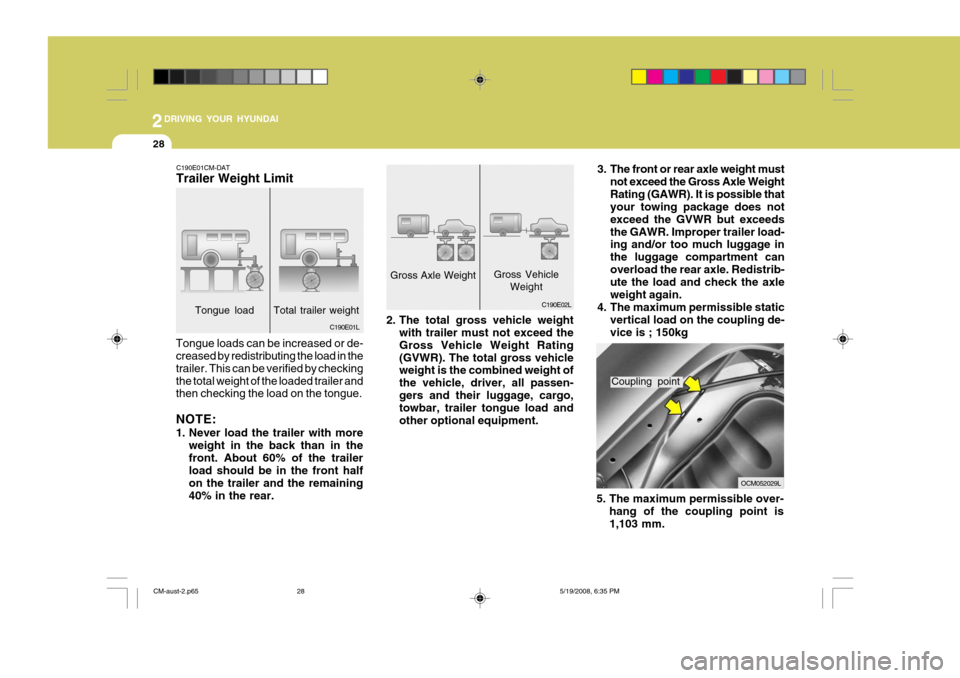
2DRIVING YOUR HYUNDAI
28
3. The front or rear axle weight mustnot exceed the Gross Axle Weight Rating (GAWR). It is possible that your towing package does not exceed the GVWR but exceedsthe GAWR. Improper trailer load- ing and/or too much luggage in the luggage compartment canoverload the rear axle. Redistrib- ute the load and check the axle weight again.
4. The maximum permissible static vertical load on the coupling de-vice is ; 150kg
2. The total gross vehicle weight with trailer must not exceed the Gross Vehicle Weight Rating(GVWR). The total gross vehicle weight is the combined weight of the vehicle, driver, all passen-gers and their luggage, cargo, towbar, trailer tongue load and other optional equipment.
Gross Axle Weight
Gross Vehicle
Weight
C190E02L
C190E01CM-DAT Trailer Weight Limit
Tongue loads can be increased or de- creased by redistributing the load in the trailer. This can be verified by checkingthe total weight of the loaded trailer and then checking the load on the tongue. NOTE:
1. Never load the trailer with more weight in the back than in the front. About 60% of the trailer load should be in the front half on the trailer and the remaining40% in the rear. C190E01L
Tongue load Total trailer weight
Coupling point
OCM052029L
5. The maximum permissible over- hang of the coupling point is 1,103 mm.
CM-aust-2.p65 5/19/2008, 6:35 PM
28
Page 174 of 269
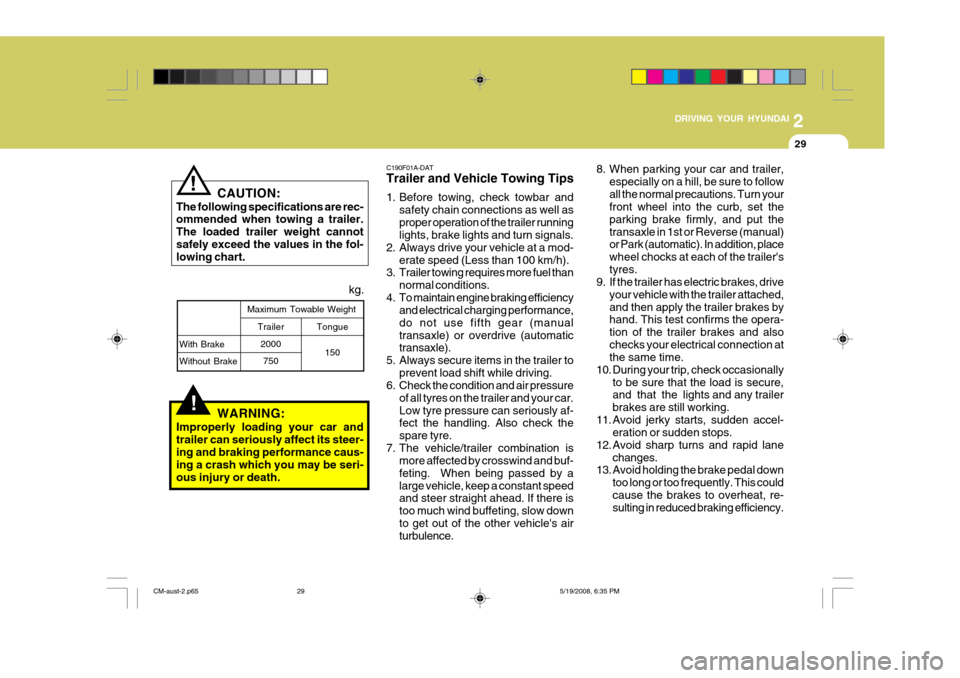
2
DRIVING YOUR HYUNDAI
29
!
C190F01A-DAT Trailer and Vehicle Towing Tips
1. Before towing, check towbar and
safety chain connections as well as proper operation of the trailer running lights, brake lights and turn signals.
2. Always drive your vehicle at a mod- erate speed (Less than 100 km/h).
3. Trailer towing requires more fuel than
normal conditions.
4. To maintain engine braking efficiency and electrical charging performance, do not use fifth gear (manualtransaxle) or overdrive (automatic transaxle).
5. Always secure items in the trailer to prevent load shift while driving.
6. Check the condition and air pressure
of all tyres on the trailer and your car. Low tyre pressure can seriously af- fect the handling. Also check the spare tyre.
7. The vehicle/trailer combination is more affected by crosswind and buf-feting. When being passed by alarge vehicle, keep a constant speed and steer straight ahead. If there is too much wind buffeting, slow downto get out of the other vehicle's air turbulence. 8. When parking your car and trailer,
especially on a hill, be sure to follow all the normal precautions. Turn your front wheel into the curb, set the parking brake firmly, and put thetransaxle in 1st or Reverse (manual) or Park (automatic). In addition, place wheel chocks at each of the trailer'styres.
9. If the trailer has electric brakes, drive
your vehicle with the trailer attached,and then apply the trailer brakes by hand. This test confirms the opera- tion of the trailer brakes and alsochecks your electrical connection at the same time.
10. During your trip, check occasionally to be sure that the load is secure,and that the lights and any trailer brakes are still working.
11. Avoid jerky starts, sudden accel- eration or sudden stops.
12. Avoid sharp turns and rapid lane changes.
13. Avoid holding the brake pedal down
too long or too frequently. This couldcause the brakes to overheat, re- sulting in reduced braking efficiency.
CAUTION:
The following specifications are rec-ommended when towing a trailer. The loaded trailer weight cannotsafely exceed the values in the fol- lowing chart.
!
Maximum Towable Weight kg.
With Brake Without Brake
WARNING:
Improperly loading your car and trailer can seriously affect its steer-ing and braking performance caus- ing a crash which you may be seri- ous injury or death.
Tongue
150
Trailer
2000750
CM-aust-2.p65 5/19/2008, 6:35 PM
29
Page 203 of 269
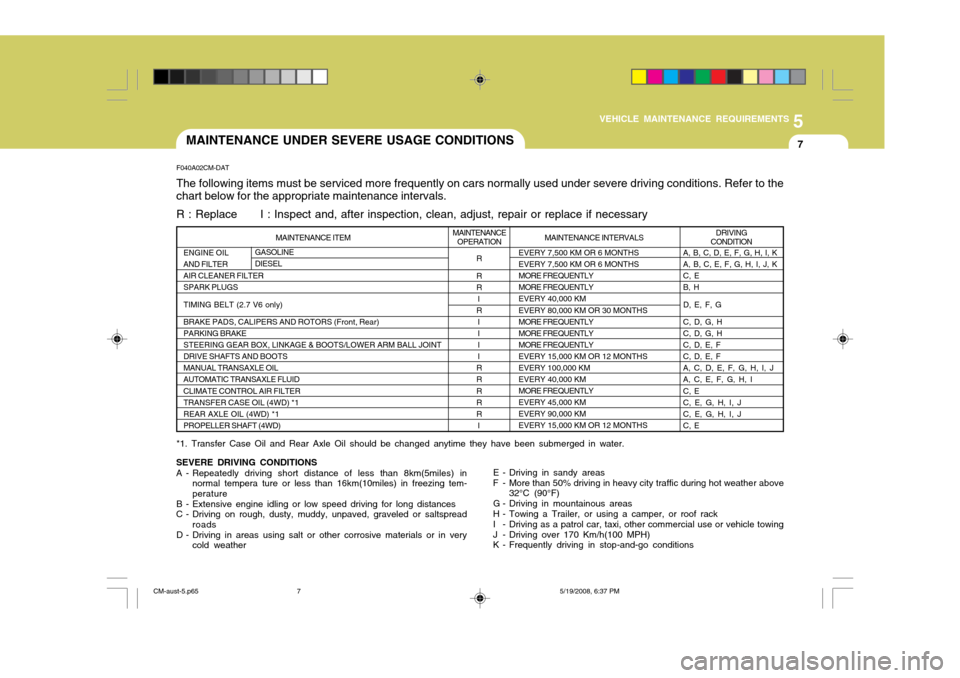
5
VEHICLE MAINTENANCE REQUIREMENTS
7MAINTENANCE UNDER SEVERE USAGE CONDITIONS
F040A02CM-DAT The following items must be serviced more frequently on cars normally used under severe driving conditions. Refer to the chart below for the appropriate maintenance intervals. R : Replace I : Inspect and, after inspection, clean, adjust, repair or replace if necessary
SEVERE DRIVING CONDITIONS
A - Repeatedly driving short distance of less than 8km(5miles) in normal tempera ture or less than 16km(10miles) in freezing tem- perature
B - Extensive engine idling or low speed driving for long distances
C - Driving on rough, dusty, muddy, unpaved, graveled or saltspread roads
D - Driving in areas using salt or other corrosive materials or in very cold weather E - Driving in sandy areas
F - More than 50% driving in heavy city traffic during hot weather above 32°C (90°F)
G - Driving in mountainous areas
H - Towing a Trailer, or using a camper, or roof rack
I - Driving as a patrol car, taxi, other commercial use or vehicle towing
J - Driving over 170 Km/h(100 MPH)
K - Frequently driving in stop-and-go conditions
*1. Transfer Case Oil and Rear Axle Oil should be changed anytime they have been submerged in water. MAINTENANCE INTERVALS
ENGINE OIL AND FILTERAIR CLEANER FILTERSPARK PLUGS TIMING BELT (2.7 V6 only)BRAKE PADS, CALIPERS AND ROTORS (Front, Rear) PARKING BRAKESTEERING GEAR BOX, LINKAGE & BOOTS/LOWER ARM BALL JOINTDRIVE SHAFTS AND BOOTSMANUAL TRANSAXLE OILAUTOMATIC TRANSAXLE FLUID CLIMATE CONTROL AIR FILTER TRANSFER CASE OIL (4WD) *1REAR AXLE OIL (4WD) *1PROPELLER SHAFT (4WD)
A, B, C, D, E, F, G, H, I, K A, B, C, E, F, G, H, I, J, KC, EB, H D, E, F, GC, D, G, H C, D, G, HC, D, E, FC, D, E, FA, C, D, E, F, G, H, I, JA, C, E, F, G, H, I C, E C, E, G, H, I, JC, E, G, H, I, JC, E
MAINTENANCE ITEM DRIVING
CONDITION
EVERY 7,500 KM OR 6 MONTHS EVERY 7,500 KM OR 6 MONTHSMORE FREQUENTLYMORE FREQUENTLYEVERY 40,000 KM EVERY 80,000 KM OR 30 MONTHS MORE FREQUENTLYMORE FREQUENTLYMORE FREQUENTLYEVERY 15,000 KM OR 12 MONTHSEVERY 100,000 KM EVERY 40,000 KM MORE FREQUENTLYEVERY 45,000 KMEVERY 90,000 KMEVERY 15,000 KM OR 12 MONTHS
R R R
I
R
IIII
RR R RR
I
MAINTENANCE
OPERATIONGASOLINE DIESEL
CM-aust-5.p65 5/19/2008, 6:37 PM
7
Page 268 of 269
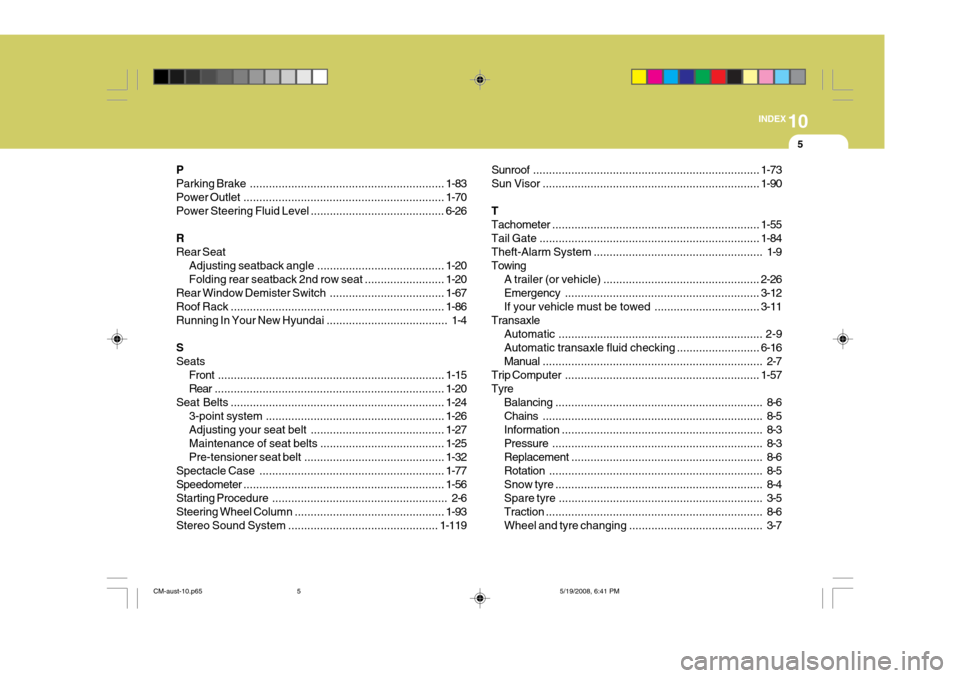
5
10
INDEX
P Parking Brake
............................................................. 1-83
Power Outlet ............................................................... 1-70
Power Steering Fluid Level .......................................... 6-26
RRear Seat Adjusting seatback angle ........................................ 1-20
Folding rear seatback 2nd row seat .........................1-20
Rear Window Demist er Switch .................................... 1-67
Roof Rack ................................................................... 1-86
Running In Your New Hyundai ...................................... 1-4
SSeats Front ....................................................................... 1-15
Rear ........................................................................ 1-20
Seat Bel ts ................................................................... 1-24
3-point system ........................................................ 1-26
Adjusting your seat belt .......................................... 1-27
Maintenance of seat belts ....................................... 1-25
Pre-tensioner seat belt ............................................ 1-32
Spectacle Case .......................................................... 1-77
Speedometer ............................................................... 1-56
Starting Procedure ....................................................... 2-6
Steering Wheel Col umn ............................................... 1-93
Stereo Sound System ............................................... 1-119Sunroof
....................................................................... 1-73
Sun Visor .................................................................... 1-90
TTachometer ................................................................. 1-55
Tail Gate ..................................................................... 1-84
Theft-Alarm System ..................................................... 1-9
Towing A trailer (o r vehicle) ................................................. 2-26
Emergency ............................................................. 3-12
If your vehicle must be towed ................................. 3-11
Transaxle Automatic ................................................................ 2-9Automatic transaxle fluid checking .......................... 6-16
Manual ..................................................................... 2-7
Trip Computer ............................................................. 1-57
Tyre Balancing ................................................................. 8-6
Chains ..................................................................... 8-5
Information ............................................................... 8-3
Pressure .................................................................. 8-3
Replacement ............................................................ 8-6
Rotation ................................................................... 8-5
Snow tyre ................................................................. 8-4
Spare tyre ................................................................ 3-5Traction .................................................................... 8-6
Wheel and tyre changing .......................................... 3-7
CM-aust-10.p65 5/19/2008, 6:41 PM
5